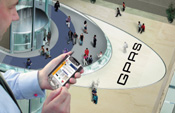|
GPRS. What is GPRS and why GPRS? That is the question.
We know, that we are on the brink of a technology change. We have already moved a big step ahead in the feild of Wirefree Communication. With the onset of the GSM technology, we were quite too happy to use the devices to talk to one another, while on the move.
Now, we need more. As the time as gone by, we are now sending data, however, small data, in the nature of SMS, or the Short Message Service. This service, uniquely, has a Gateway Interface. Due to its cost effectiveness, SMS now rules over everyone's minds. That's why, I precisely call it the Student's Economy Provider. SMS, however, has some backdrops. It allows us to send only a 161 character message, over a GSM Network.
Moreover, with the increase in technology and tech based appliances, we are now able to access the internet, and internet applications on our GSM Phone. Such Internet Applications may include the use of Messengers, like Yahoo messenger facility, and also the email automatic notification. However, this also is featuring via the SMS Gateways only. To access the Internet, we need that our phone must be a "WAP Client" (2G Technology) and also, we need to log in to a WAP site to access and interact with the world.
In all the above scenarios, look at the gradual increase in the amount of the data transfer. Also, the data transfer rate and bandwidth must increase, with the increase in technology. Now, here at the IMT UMTS, people are now projecting the amount of data transfer, and thus, a critical amount of the data transfer rate required. Now if we look at the projection to about 5 years from now, the equations do not match. The Infrastructure in GSM or any other present network, even hypothetic, cannot support the data interaction.
Within a decade or so from now on, IMT - UMTS reports that the amount of data transfered in the networks, will surpass the amount of voice calls. Thus, exactly what it really means, is that Data interaction will increase so drastically, that the voice communication will run on sidelines.
Considering the problem above, don't you think that we seriously need to work in the direction, of bringing a new technology? The answer has to be YES.
With the Answer of the above problem, the IMT - UMTS 2000, charted out a conceptual communication generation, the 3G ( 3rd Generation Comm.)
The 3G featured the following clause :
Average speeds for 3G networks will range between 64Kbps and 384Kbps, throughputs excluded.
|
 |
|
The time was right for the strike. The Strike came in the form of GPRS -- The General Packet Radio Service.
The GPRS uses a fairly simple concept of Packet Switching, which makes this technology, so popular in the global scenario. While on a GPRS application, you will get a feeling of being always on.
While on any other network, and accessing internet, you are generally billed by the number of hours you spend online. But, with the onset of such a technology, the billing will be done not on the basis of the no. of hours you spend, but the actual amount of data interaction and transfer that takes place on the machiene. Thus making you feel that you were never offline, and you can easily control your billing amount, and data management.

|
| The New Phone -- Thanks to GPRS |
|
|  |
|
Now, this clause means, turning mobile phones, into multmedia players, making it possible to download music and video clips. A mobile phone can be the ultimate business, personal, educational, and leisure tool. With the 3G communication network, you can send LIVE pictures through your cell phone, as you would do, with a video camera, with perfect QoS.
The clauses have been framed, and the definitions ready. But who will take the initiative?
The initiative was taken by Telecom engineers from Japan. The design of the new service is called the freedom of mobile multimedia access (FOMA). FOMA was the first step to design a 3G application, using, a much expertly designed technology, known as the Wideband Code Division Multiple Access (W-CDMA). This technology was invented to make the infrastructure capable of transfering large amount of data.
W-CDMA sends data in a digital format over a range of frequencies, which makes the data move faster, but also uses more bandwidth than digital voice services. With this major drawback, the IMT - UMTS 2000 rejected it as to be included in the 3G protocol and application family.
The Japan's child FOMA, is available in a 20-mile radius around the center of Tokyo, and company plans to introduce it to other Japanese cities by the end of the year. But services and phones are expensive and uptake of this market is expected to be slow.
Several other organizations and companies tried to persue the IMT - UMTS, but they failed to do so.
GPRS For Me? I don't Think so ...
This is the most possible question is anybody's mind. While being an average cellphone user, why would you use GPRS, and even, why would you require this technology?
The answer is pretty simple. Do you check email? yes . Are you a part of any messenger... yahoo etc..? yes. Do you get take part in the SMS contests and polls? yes. Then you surely require GPRS.
Do you know, that you are paying even for those ringtones that you download, from Yahoo, that you don't recieve or do not save? Yes you are paying for every outgoing message, no matter its being acknowledged or not. with GPRS, you will not face bills of the messages that were of no use to you.
|
 |
|
|

